CASTRES – AN UNKNOWN GEM IN THE LANGUEDOC, AND A RUINED ABBEY
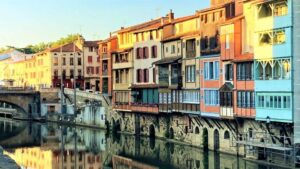
We have been travelling around the Languedoc region on and off for many years, and this time, as well as returning to some old favourites, we were keen to seek out a few places and sights we hadn’t visited before. We thought we would drive from Marseille up towards Bordeaux, and during our research, we kept coming across the name of what sounded like a most interesting town. Located about 73 kms east of Toulouse and 45 kms south east of Albi, lies the picturesque town of Castres, intersected by two rivers, the Durenque and Agout. The town developed around an early Benedictine Abbey and became famous in medieval times for its tanneries and textile houses, particularly for the wool trade, that depended on the flow of the river Agout. Today, known for its 12th century coloured houses built along the banks of the river, Castres has often been dubbed ‘the Venice of Languedoc’.

A former textile town, Castres has been a busy centre of trade and industry for over 2,000 years, but has been inhabited since the Bronze Age, around 1,000BCE. You can glimpse these businesses on the banks of the river Agout, where the medieval tanners’ houses were built. They were constructed with basement doors to help the workers get the animal skins down to the water where they were cleansed and rinsed, then put into tanks full of lime. The ground floor was occupied by the workers with the masters living above. On the top two floors were the drying sheds, with shuttered openings protecting the hides from the sun during summer, and from frost during the winter. Under the roof, the “soleiller”, or second drying shed, was left wide open to let the air and light in. Today, the façades of these pretty houses and their balconies facing the river are brightly painted, and have become one of the main attractions of the town.
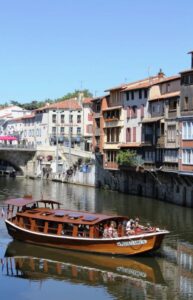
Castres has an easy-going pace and is a delightful town to stroll around. When you feel in need of a rest, a relaxing way to view the houses along the banks of the river Agout is to take a trip along the river aboard the “Miredames”, a replica 17th century barge. Shuttle boats run from May until mid-October, up to seven trips a day. Boats leave from the town centre to Gourjade Park, 20 mins. upriver, where passengers can disembark and wait for the next shuttle boat for the return journey if they wish.
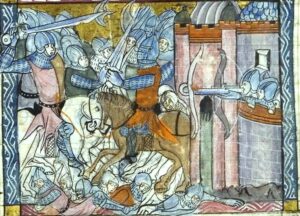
The site of a Gallo-Roman encampment, the town gradually developed around a Benedictine monastery founded about 647 and the town was ruled by a college of consuls. During the Albigensian Crusade against the Cathars, it surrendered to Simon de Montfort, whose brother Guy held the territory as feudal lord, as part of the kingdom of France. The town suffered greatly from the Black Plague in 1347-48, then from incursions by England’s Black Prince as well as bands of lawless mercenaries, who laid waste to the country during the Hundred Years’ War. These disasters, coupled with the town being fought over by various Dukes and Counts with loyalties to different factions of the French crown, meant that by the late 14th century, Castres was in sharp decline.

Around 1560, the majority of the population of Castres converted to Protestantism. The inhabitants fortified the town and established an independent republic. Castres was one of the largest Protestant strongholds in southern France, along with Montauban and La Rochelle. Henry of Navarre, leader of the Protestant party, who later became King Henry IV of France, stayed in Castres in 1585, and later chose the town as the home of the Court of the Chamber of the Edict. The fortifications were later dismantled on orders of the Crown, and after these religious wars, the town, finally at peace, enjoyed a period of rapid expansion. Traditional commercial activities revived, in particular, fur and leather tanning, and above all, the wool trade. Culture also flourished, and having been turned into a catholic town, several convents were established.
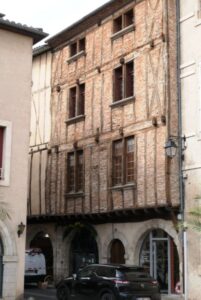
In the 17th century, Castres was the location of an important law courts, settling disputes between Catholics and Protestants. The elegant Renaissance mansions built for the magistrates can still be seen as you explore the town 400 years later.

On our walk through the historic heart of the town, we discovered a number of notable 17th century mansions, including the Hotel de Nayrac, built in the Toulouse-style blend of limestone and brick, and Hotel Vivies, built for a lawyer in the Chamber of the Edict. The impressive Hotel de Poncet has some interesting Renaissance sculpture adorning the façade, an elegant loggia and Doric columns and a balustrade supported by 4 rather bizarre caryatids. The house was once the family home of one John Ligonier, the son of protestant Huguenots who was forced to flee to England with most of his family at the age of 5. He rose to become a Field Marshal in the British Army.

Perhaps the most prominent landmark building in Castres is the Bishop’s Palace, which is now the Hotel de Ville. It was designed by Mansart, the architect of the Palace of Versailles, while the beautiful garden, Le Jardin de l’Évêché, was designed by André Le Notre, the famous 17th century landscape gardener who designed the gardens at Versailles. More than 300 years later, the boxwood hedges follow the exact pattern as laid out by Le Notre.
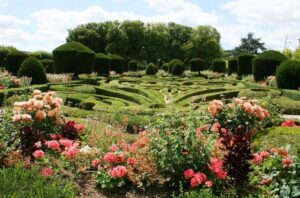
The Jardin de l’Évêché has a slightly trapezoid shape so that it would seem symmetrical looking out from the windows of the palace. As well as the formal parterres, there are four English flowerbeds and a chestnut grove at the back.
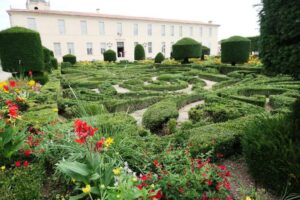
Also housed in the former Bishop’s Palace is the Goya Museum, one of the town’s major attractions. The collection contains three works by Goya himself and other important Spanish artists such as Velasquez, Murillo and Zurbarán. The 20th century gallery has works by Picasso, Juan Gris and Antoni Clavé. It’s the only French museum that offers such a complete overview of Spanish art, but there are also ceramics, weapons and pre-Columbian decorative artefacts.
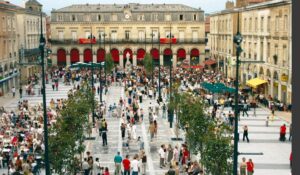
Castres’ most famous son was the French politician Jean Jaurès, born there in 1859. He was one of the first social democrats and a pacifist, vehemently opposed to war, and regarded by many as Europe’s last hope for peace in 1914. He was assassinated on 31 July, and WW1 started 3 days later. He opposed colonisation and fought for the separation of church and state. A symbol of the French Republic values of Liberté, Égalité and Fraternité, it would be hard to find a village, town or city in France that hasn’t got a Place Jean Jaurès, boulevard or street named after him. Politically, Jaurès was to the Left what de Gaulle was to the Right.

We came across the museum, the Centre National et Musée Jean-Jaurès, dedicated to the man and his achievements, and immediately after the war, the town’s rectangular main square was renamed in his honour. This centre is a resource for students and academics, and there’s a permanent exhibition of documents, newspaper extracts, film, photos, caricatures and personal artefacts.

Most prominent in Place Jean Jaurès is an imposing marble statue of the man himself, placed with his back to the river Agout. The Place is surrounded by cafes and restaurants, perfect for al fresco dining and coffee breaks, making it the town’s most popular location for locals to socialise and meet friends. The architecture around the square is very fine, with rows of arcades that have been filled in by bars and shops on all but one side, and a pedestrianised shopping area around it. The square is the location for a very good outdoor market on Tuesday, Thursdays, Fridays and Saturday mornings.
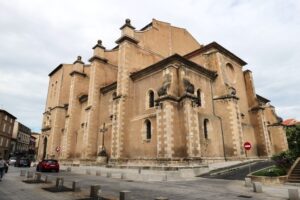
The main religious monument in Castres is the Église Saint-Benoit, which was built in the 17th century and was originally a cathedral, and is still sometimes referred to as Castres cathedral. The oldest church in town is the Église Notre Dame de la Plate, and the pilgrim church, Église Saint-Jacques de Villegoudou.
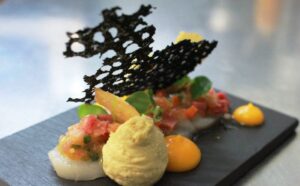
One of the best things about dining out in Castres is that you can have a meal where virtually every course is a local or regional speciality. A menu is sure to include melsat, a typical charcuterie made from pork, or gougnette, which is served cold, and involves pork belly, breadcrumbs and egg cut into slices. Main courses are sure to feature confit of duck or a local version of cassoulet, and for dessert you will likely find poumpet, a flaky pastry filled with a lemon and orange cream paste. This local favourite was brought to the area by the Moors in the Middle Ages.

Just a short drive 16 kms to the north east of Castres, is one of the great natural sites of France. The terrain becomes steeper as you enter the southern reaches of the Massif Central, and it’s here on a large granite plateau you’ll find Sidobre, with its outlandish rock formations, especially the “Riviere des Rochers”, a river valley full of misshapen rocks and boulders. Stretching over 15 kms long and about 7 kms wide, for scale and sheet number of huge, strange-shaped granite boulders and natural formations, there’s no other place quite like it in Europe. It’s easy to understand how mythological stories and legends dating back millennia have evolved. The Maison de Sidobre is a tourist centre providing maps and ideas for walks and other activities.
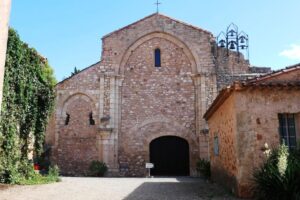
Somewhat further away, but perfect for either an easy day trip from Castres or a visit en route to or from there, is the Abbaye de Fontcaude. This 12th century abbey, ruined during the Revolution, is a listed Monument Historique, close to a sacred spring where canons settled around 1154. This exceptional site is the last remaining example of Romanesque architecture in the Languedoc region. Partially burned during the 16th century Wars of Religion, it has undergone an outstanding restoration, which included the abbey church, a cloister, an oil mill, a museum of Gothic sculptures and a 12th century bell foundry.

Situated on one of the pilgrimage routes to Santiago de Compostela, these days the abbey is also renowned for its regular programs of concerts of Gregorian chants. The abbey is around 84 kms from Castres and 20 kms from Beziers if you’re heading south.
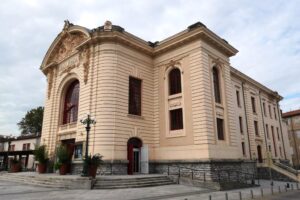
Getting to Castres: Castres is very accessible from many major towns in France. It has its own railway station, and for example from Toulouse it takes around 1 hr 15 mins. by direct train. There are buses from various major cities, and by car from Bordeaux it takes around 3hrs 45 mins. We drove to Castres from Aigues Mortes, one of our top favourite destinations right on the Mediterranean coast about an hour 35 mins from Marseille, staying in one of our favourite hotels, Hotel des Remparts. En route to Castres, we took a fascinating detour to visit the remains of the beautiful Abbaye de Fontcaude, described above.



What an interesting area. I guess you both enjoyed the ancient architecture and the history of its more modern inhabitants.
A most enjoyable blog.
Warm regards, Annette & Tony
Hi Tony and Annette,
It was a most interesting town. We kept seeing it on “must visit” lists for that region, so of course, we had to include it. These towns have such a fascinating history, when you realise how ancient some of these places are, and what turbulent times they survived! So glad you enjoyed the story.
Best regards, Cheryl